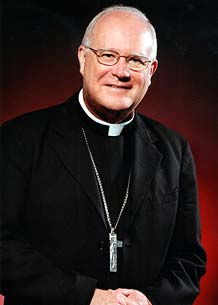December 8th, 2010
By Archbishop George Niederauer
 Together with my good friend and brother in faith, His Eminence Metropolitan Gerasimos of the Greek Orthodox Metropolis of San Francisco, I was privileged to join 28 Orthodox and Catholics on an ecumenical pilgrimage to Rome, Athens and Constantinople (Istanbul), Nov.21-Dec. 2. Why a pilgrimage? Church reunion cannot simply be imposed from the top, a “trickle down” process from patriarchs, popes and theologians to laymen and women, parishioners in the pews. The grassroots Christians of Orthodoxy and Catholicism need to meet and get to know each other and each other’s churches and traditions. We need to pray together, to work together, and to like and love each other. That’s why 28 of us made “A Journey of Faith: East and West.”
Together with my good friend and brother in faith, His Eminence Metropolitan Gerasimos of the Greek Orthodox Metropolis of San Francisco, I was privileged to join 28 Orthodox and Catholics on an ecumenical pilgrimage to Rome, Athens and Constantinople (Istanbul), Nov.21-Dec. 2. Why a pilgrimage? Church reunion cannot simply be imposed from the top, a “trickle down” process from patriarchs, popes and theologians to laymen and women, parishioners in the pews. The grassroots Christians of Orthodoxy and Catholicism need to meet and get to know each other and each other’s churches and traditions. We need to pray together, to work together, and to like and love each other. That’s why 28 of us made “A Journey of Faith: East and West.”
Other clergy pilgrims included Metropolitan Nikitas, based at The Patriarch Athenagoras Orthodox Institute in Berkeley; Father John Bakas, pastor of St. Sophia Cathedral in Los Angeles; as well as Bishop Tod Brown of Orange; Auxiliary Bishop William Justice of San Francisco; and Msgr. John Talesfore, rector of St. Mary of the Assumption Cathedral in San Francisco. The other 21 participants were laywomen and men, about evenly divided between Orthodox and Catholics.
At the present time Orthodox Christians throughout the world number about 300 million, Catholics about 1.1 billion. For the first 1,000 years of Christian history the churches of the East and the West were united in faith and worship. They recognized and prayed for one another, and met in Council, especially to preserve unity in the teaching of the faith. Over time, differences in language, faith expression and culture, as well as the difficulties of effective communication, led to misunderstandings and to a definitive break or schism in 1054 A.D. Periodic efforts at reunion failed, in no small part because of historical misdeeds such as the Fourth Crusade, in 1204.
After 900 years of silence, distrust and misunderstanding, Orthodox Patriarch Athenagoras and Pope John XXIII began a mutual fraternal outreach that has widened and developed during the last fifty years. During that time the Ecumenical Patriarchs in Constantinople and the Popes in Rome have met with each other and have withdrawn historic official declarations against each other. For years now there have been regular international meetings of Orthodox and Catholic representatives, and here in the United States the North American Orthodox-Catholic Theological Consultation continues to meet to discuss steps toward a reunited Church in full communion (this Consultation’s most recent meeting issued a joint communiqué on Oct. 2 of this year.)
The emphasis along this path toward reunion is necessarily on what we Orthodox and Catholics have in common, while acknowledging and working through the real differences and stumbling blocks. What we share gives us joy and hope: the common Creed of the Council of Nicaea (325 A.D.), the teaching of the Apostles and the ordained ministry passed down from them, the inspired Word of God in Scripture, the seven sacraments (most centrally, the Eucharist), a shared moral teaching, as well as an understanding of faith and an appreciation of Christian spirituality rooted in the Fathers of the Church, East and West, including St. Augustine, St. John Chrysostom, St. Leo the Great, St. Gregory Nazianzen and St. Basil.
In future articles I hope to share with you some of our experiences on this ecumenical pilgrimage.
From December 10, 2010 issue of Catholic San Francisco.